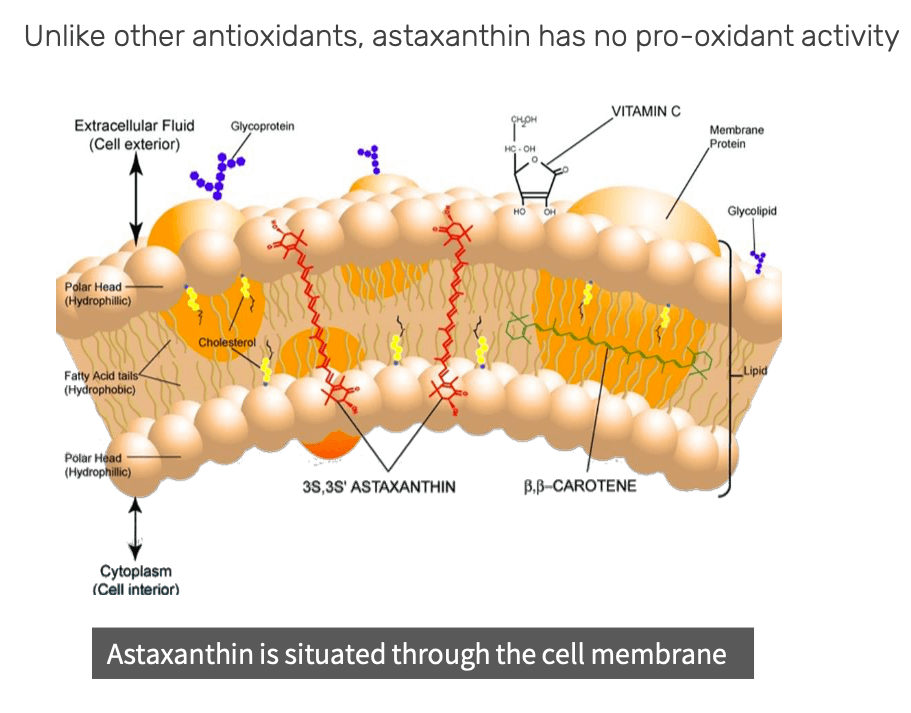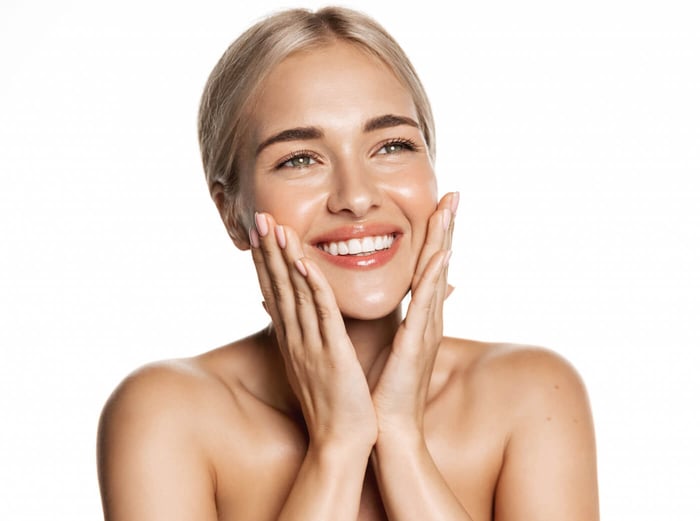Table of Contents
What is the Heckety Heck is Astaxanthin?
Astaxanthin is a carotenoid. That means it’s in the same class as beta-carotene, the extraordinary molecule that gives carrots their orangeness.
Astaxanthin, too, has a red-orange hue.
Astaxanthin comes from the marine biosystem, and its presence was first discovered by humans in lobsters.
Lobsters don’t actually make the pigment, though. They get it from eating algae that is high in astaxanthin! The alga is called Haematococcus pluvialis.
One of the Most Powerful Antioxidants
Antioxidants work by clearing free radicals from the body. There are hundreds, perhaps thousands, of antioxidants.
Most people know about the ones that have gotten a lot of media and have been extensively studied, like vitamin C, green tea, and berries.
All antioxidants are thought to be helpful and may reverse the bad effects of aging. But here’s what’s really interesting: antioxidants are not all created equal. Some are way more powerful and effective than others.
Many commonly used antioxidants in expensive skin serums don’t come close to the power of astaxanthin.
Unlike other antioxidants, astaxanthin has no pro-oxidant activity.
Astaxanthin is like no other antioxidant. It is hydrophilic (water-loving) and hydrophobic ( doesn't like water), making it unique for its extraordinary performance.
See the diagram showing Vitamin C vs Astaxanthin.

Astaxanthin is the best antioxidant I’ve found after years of research. There are hundreds of studies about it and other antioxidants have been published. The ones that interest me most are the peer-reviewed articles that suggest that it clears the body of free radicals so effectively that it is more powerful than several different carotenoids and over a thousand times more potent than vitamin C!
People interested in nutrition spend a lot of time thinking about and comparing ORAC values. ORAC stands for Oxygen Radical Absorbance Capacity. Developed by Tufts University researchers for the Food and Drug Administration, ORAC is a reliable way to determine the antioxidant capacity.
I talk about ORAC values all the time! Important takeaway: the higher the score, the more powerful the antioxidant. So, we want to eat foods, use topical serums with high ORAC scores, and use skin care products made from these ingredients.
Astaxanthin has an ORAC score of 2,822,200. That means it’s hundreds of times more potent than wild blueberries, 293 times, according to nutritionist Maxine Sheils, who cites research showing that it is good for your muscles, skin, brain, heart, and even eyesight.
Astaxanthin has the second-highest ORAC value ever measured! The only thing that beats it to date is the sap from the lechleri tree called Dragon’s Blood. I have seen this tree in Costa Rica and it sap is bright red, similar in color to Astaxanthin.
Dragon’s Blood 2,897,110
Astaxanthin 2,822,200
Cloves 290,283
Rosemary 165,280
Acai berries 102,700
Wild blueberries 9,621
If you want to check the ORAC value of food, Superfoodly keeps an updated and searchable database with these numbers.
Why is Astaxanthin Such a Powerful Antioxidant?
Tropical algae, found in both fresh and salt water, are thought to be the best and richest source of natural astaxanthin, and astaxanthin is a “super anti-oxidant,” according to a 2016 peer-reviewed article in the journal Frontiers in Plant Science.
Geek out with me about this for another minute. These creatures, Haematococcus pluvialis, that contain so much astaxanthin are micro-algae, individual tiny units that live free-floating as plankton in the water (as opposed to macro-algae like seaweeds). They live by photosynthesis, which means they convert sunlight into energy.
This kind of algae thrives on sunlight and is normally green. But excessive sunlight can be harmful to them it stresses the algae to the point of death, however they make Astaxanthin to surviveve, to protect themselves from too much sunlight while still getting the light they need to survive. If they don't make Astaxanthin they die!
So astaxanthin is a defense mechanism of the algae: H. pluvialis produces astaxanthin when it’s under environmental stress—from excessive light, heat, salt, or radiation, or from dehydration or lack of nutrients. Then the alga pauses its growth and goes into a dormant protective form, all the while making astaxanthin.
The chlorophyll-green algae start filling with the astaxanthin, which is a rich vermillion-red, the opposite of the chlorophyll’s color, in order to stop picking up all the sun’s energy. The astaxanthin blocks the sun and protects the algae.
These tiny creatures protect themselves from harmful UV light by producing astaxanthin!
Most antioxidants are found in plants but astaxanthin is in algae and astaxanthin actually protects the algae’s DNA from damage.
See why I’m obsessed?!
Repairing & Rejuvenating Power?
If astaxanthin can protect algae, can’t it also protect humans? The answer is a resounding yes. That’s why I developed a skin serum and a USDA organic astaxanthin supplement, USDA organic Bliss Body Serum that contains 100% organic astaxanthin. Covering your skin with my serum will keep your skin protected and rejuvenated and taking the supplement will from your glowing from the inside out.

Skin aging is mainly the result of damaged proteins in your skin cells’ membranes. We combat this with antioxidants because the damage is the result of oxidative stress from pollutants in the environment or in our bodies.
Oxidative stress can come from LED lights, blue light from all screens, infrared rays from the sun, UV, stress, diet, alcohol, smoking, or even emotional distress.
Often courtesy of the free radicals I mentioned earlier, which can wreak havoc on our cells.
Astaxanthin has been called the “king of the carotenoids.” It’s been shown to increase the collagen content of the skin, facilitating the skin’s natural self-repair.
A 2012 study by scientists in Japan found that it improves the skin’s elasticity, texture, and moisture content.
It really is a super antioxidant, protecting you inside and out.

Organic Astaxanthin Only, Avoid Synthetic Forms
Luxe Beauty's antioxidant serum and our organic astaxanthin supplement contains USDA-certified organic astaxanthin, USDA organic Bliss Body Serum. It took over two years of research to find a certified organic source! Avoid "Natural" Asthanthan because it can be grown with nitrates and not tested or controlled for contaminates or grown with pristine water. Also you never want to consume Astaxanthin with cheap seed oils, such as sunflower or safflower oil.
Our USDA organic astaxanthin comes from living microalgae, but there are synthetic versions on the market derived from petrochemicals. To obtain their reddish color, farmed salmon are fed synthetic astaxanthin.
From raw material to end product, we go to great lengths to ensure that our pure microalgae-derived astaxanthin is produced naturally, just as nature has been doing for the past 1.5 billion years. Our source has pioneered the knowledge and expertise to cultivate microalgae in a patented, eco-friendly, closed system free of contaminants and toxins. Using the desert’s sunlight, our manufacturing process is completely sustainable, relying on power generated in a solar panel farm and our water recycling platform. Our microalgae cultivation displaces no crops, utilizes carbon dioxide, and creates only oxygen as waste. It is a genuine ecological crop.
A Skeptic Changes His Mind
When I introduced my astaxanthin skin serum to my friend Jennifer, she brought some home for her husband, who worries about skin cancer.
He read the ingredients on the label and frowned.
“How’s this going to help my skin?!” he cried.
But he’s a science nerd, and Jennifer gave him an earful (I have that effect on people). Her husband took matters into his own hands and started researching astaxanthin himself. Once he discovered how astaxanthin can protect the skin, bringing with it all the helpful effects of antioxidants and being good for the environment, he was hooked. Now, he won’t leave home without it.
An email received from Lily in Santa Monica, CA:
“I adore the antioxidant serum. I have been using it regularly since we spoke, and I haven’t burned on my face, yet I retain a brighter glow. Additionally, I was away on vacation and scraped my arm badly. I didn't bring any first aid supplies but had my toiletries. Long story short, I used the antioxidant serum as a sort of skin food healing salve, and it healed rapidly with minimal scarring. Thought you might appreciate the testimonial.”
*The information on this website and the products on the website are not intended to diagnose, treat, or prevent any disease or to affect any structure or function of the skin or body. Medical advice for skin or otherwise must be made in consultation with a healthcare provider.







